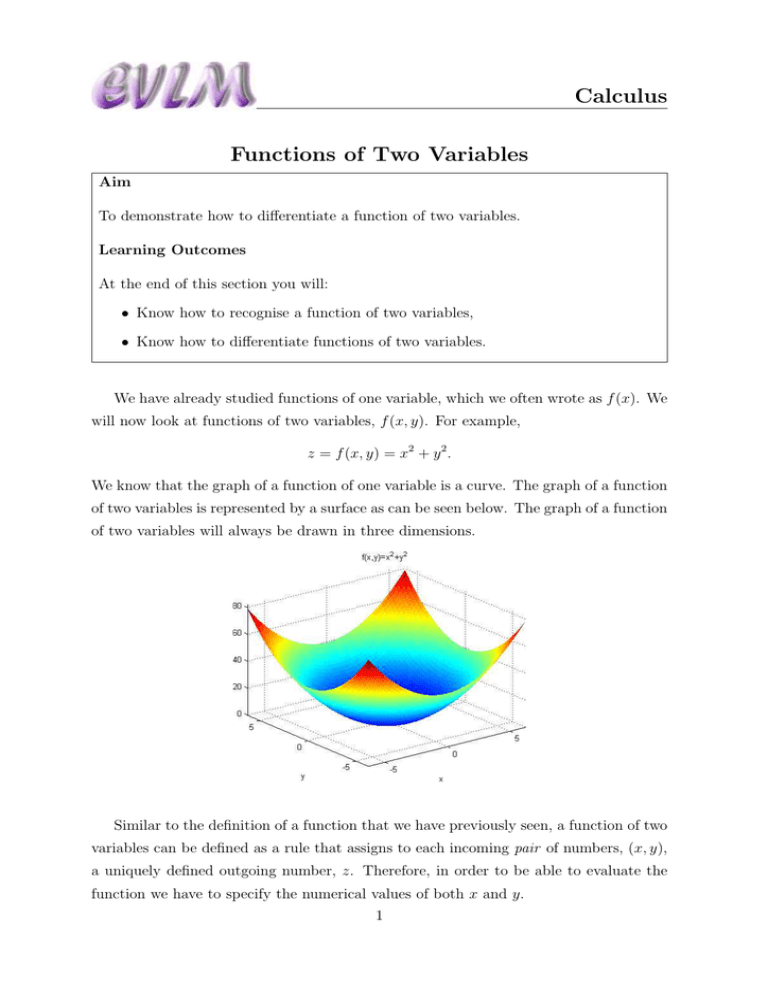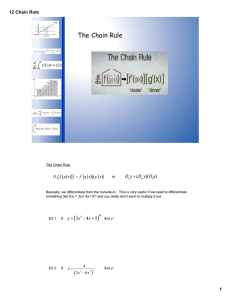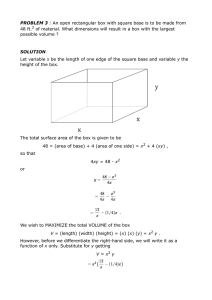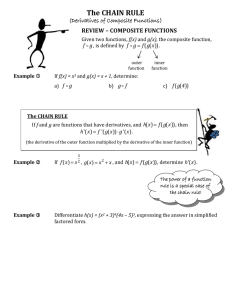Calculus Functions of Two Variables
advertisement

Calculus Functions of Two Variables Aim To demonstrate how to differentiate a function of two variables. Learning Outcomes At the end of this section you will: • Know how to recognise a function of two variables, • Know how to differentiate functions of two variables. We have already studied functions of one variable, which we often wrote as f (x). We will now look at functions of two variables, f (x, y). For example, z = f (x, y) = x2 + y 2 . We know that the graph of a function of one variable is a curve. The graph of a function of two variables is represented by a surface as can be seen below. The graph of a function of two variables will always be drawn in three dimensions. Similar to the definition of a function that we have previously seen, a function of two variables can be defined as a rule that assigns to each incoming pair of numbers, (x, y), a uniquely defined outgoing number, z. Therefore, in order to be able to evaluate the function we have to specify the numerical values of both x and y. 1 Calculus Partial Differentiation Given a function of two variables, z = f (x, y) we can determine two first-order derivatives. The partial derivative of f with respect to x is written ∂z ∂x or ∂f ∂x or fx and is found by differentiating f with respect to x, with y held constant. Similarly the partial derivative of f with respect to y is written ∂z ∂y or ∂f ∂y or fy and is found by differentiating f with respect to y, with x held constant. We use the partial symbol, ∂, to distinguish partial differentiation of functions of several variables from ordinary differentiation of functions of one variable. Example 1 Differentiate the following function with respect to x, f (x, y) = x2 + y 3 By the sum rule we know that we can differentiate each part separately and then add the solutions together. When we differentiate x2 with respect to x we get 2x. When we differentiate y 3 with respect to x we get 0. To see this, note that y is treated like a constant when differentiating with respect to x. Therefore any function of y, e.g. y 3 is also treated like a constant when differentiating with respect to x and, as we already know, the differential of a constant is 0. Therefore ∂f = 2x + 0 = 2x. ∂x Example 2 Find both first-derivatives of the following function, f (x, y) = x2 y Care must be taken in this case because here we have a term consisting of both x and y. To find fx we differentiate as normal taking x as the variable and y as the constant. 2 Calculus Remember that when we differentiate a constant times a function of x we differentiate the function of x as normal and then multiply it by the constant. For example, 3x2 differentiates to give 3(2x) = 6x. In our situation, y plays the role of a constant, so x2 y differentiates to give (2x)y = 2xy. Hence fx = 2xy. Similarly, to find fy we treat y as the variable and x as the constant. When we differentiate a constant times y we just get the constant. In our case x2 plays the role of the constant, so x2 y differentiates to give x2 . Hence, f y = x2 . It is possible to find second-order derivatives of function of two variables. There are four second-order partial derivatives. The four derivatives are fxx , fyy , fxy and fyx . In general it is true that fxy ≡ fyx . Note: fxy means that we differentiate the function f first with respect to x and then we different the resulting answer, fx , with respect to y. Small Increments Formula To provide an interpretation of a partial derivative let us take one step back for a moment and recall the corresponding situation for functions of one variable of the form y = f (x). The derivative, dy , dx gives the rate of change of y with respect to x. In other words, if x changes by a small amount ∆x then the corresponding changes in y satisfies dy ∆y ' ∆x. dx The accuracy of the approximation improves as ∆x becomes smaller and smaller. Given the way in which a partial derivative is found we can deduce that for a function of two variables z = f (x, y) 3 Calculus if x changes by a small amount ∆x and y is held fixed then the corresponding change in z satisfies ∂z ∆x. ∂x Similarly, if y changes by ∆y and x is fixed then z changes by ∆z ' ∆z ' ∂z ∆y. ∂y In practice, of course, x and y may both change simultaneously. If this is the case then the net change in z will be the sum of the individual changes brought about by changes in x and y separately, so that ∆z ' ∂z ∂z ∆x + ∆y. ∂x ∂y This is referred to as the small increments formula or the total derivative. If ∆x and ∆y are allowed to tend to zero then the above formula (which was only an approximation) can be rewritten as ∂z ∂z dx + dy ∂x ∂y where the symbols dx, dy and dz are called differentials and represent limiting values of dz = ∆x, ∆y and ∆z, respectively. Related Reading Jacques, I. 1999. Mathematics for Economics and Business. 3rd Edition. Prentice Hall. 4


